
Sophia was Electress of Hanover from 19 December 1692 until 23 January 1698 as the consort of Prince Elector Ernest Augustus. She was later the heiress presumptive to the thrones of England and Scotland and Ireland under the Act of Settlement 1701, as a granddaughter of King James VI and I. Sophia died less than two months before she would have become Queen of Great Britain and Ireland. Consequently, her son George I succeeded her first cousin once removed, Queen Anne, to the British throne, and the succession to the throne has since been defined as, and composed entirely of, her legitimate and Protestant descendants.

George I was King of Great Britain and Ireland from 1 August 1714 and ruler of the Electorate of Hanover within the Holy Roman Empire from 23 January 1698 until his death in 1727. He was the first British monarch of the House of Hanover.
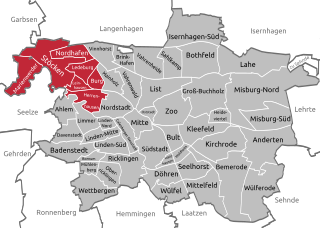
Herrenhausen-Stöcken is a borough of the German city of Hanover, northwest of the city centre. In 2020 it had a population of 37,543. It consists of the quarters Burg, Herrenhausen, Ledeburg, Leinhausen, Marienwerder and Stöcken.

The House of Hanover is a European royal house with roots tracing back to the 17th century. Its members, known as Hanoverians, ruled Hanover, Great Britain, Ireland, and the British Empire at various times during the 17th to 20th centuries. Originating as a cadet branch of the House of Welf in 1635, also known then as the House of Brunswick-Lüneburg, the Hanoverians ascended to prominence with Hanover's elevation to an Electorate in 1692. In 1714 George I, prince-elector of Hanover and a descendant of King James VI and I, assumed the throne of Great Britain and Ireland, marking the beginning of Hanoverian rule over the British Empire. At the end of his line, Queen Victoria's death in 1901, the throne of the United Kingdom passed to her eldest son Edward VII, a member of the House of Saxe-Coburg and Gotha, through his father Albert, Prince Consort. The last reigning members of the House of Hanover lost the Duchy of Brunswick in 1918 when Germany became a republic.

The Duchy of Brunswick-Lüneburg, or more properly the Duchy of Brunswick and Lüneburg, was a historical duchy that existed from the late Middle Ages to the Late Modern era within the Holy Roman Empire, until the year of its dissolution. The duchy was located in what is now northwestern Germany. Its name came from the two largest cities in the territory: Brunswick and Lüneburg.

The Principality of Calenberg was a dynastic division of the Welf Duchy of Brunswick-Lüneburg established in 1432. Calenberg was ruled by the House of Hanover from 1635 onwards; the princes received the ninth electoral dignity of the Holy Roman Empire in 1692. Their territory became the nucleus of the Electorate of Hanover, ruled in personal union with the Kingdom of Great Britain from 1714 onwards. The principality received its name from Calenberg Castle, a residence of the Brunswick dukes.

The House of Welf is a European dynasty that has included many German and British monarchs from the 11th to 20th century and Emperor Ivan VI of Russia in the 18th century. The originally Franconian family from the Meuse-Moselle area was closely related to the imperial family of the Carolingians.
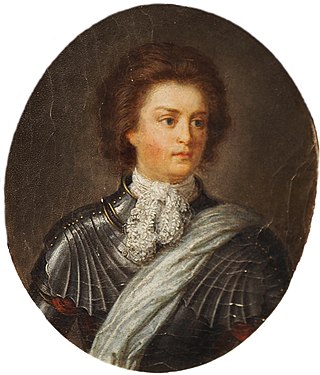
Count Philip Christoph von Königsmarck, also spelled Philipp, was a Swedish count and soldier. He was allegedly the lover of Sophia Dorothea, Princess of Celle, the wife of Duke George Louis of Brunswick and Lüneburg, the heir presumptive of the Principality of Calenberg, later to become Elector of Hanover and King of Great Britain.

The Kingdom of Hanover was established in October 1814 by the Congress of Vienna, with the restoration of George III to his Hanoverian territories after the Napoleonic era. It succeeded the former Electorate of Hanover, and joined 38 other sovereign states in the German Confederation in June 1815. The kingdom was ruled by the House of Hanover, a cadet branch of the House of Welf, in personal union with Great Britain between 1714 and 1837. Since its monarch resided in London, a viceroy, usually a younger member of the British royal family, handled the administration of the Kingdom of Hanover.

Sophia Dorothea of Brunswick-Lüneburg-Celle was the repudiated wife of future King George I of Great Britain. The union with George, her first cousin, was a marriage of state, arranged by her father George William, her father-in-law the Elector of Hanover, and her mother-in-law, Electress Sophia of Hanover, first cousin of King Charles II of England. Sophia Dorothea is best remembered for her alleged affair with Count Philip Christoph von Königsmarck that led to her being imprisoned in the Castle of Ahlden for the last thirty years of her life.

George, Duke of Brunswick-Lüneburg, ruled as Prince of Calenberg from 1635.

Ernest Augustus, Duke of Brunswick-Lüneburg, was Prince of Calenberg from 1679 until his death, and father of George I of Great Britain. He was appointed as the ninth prince-elector of the Holy Roman Empire in 1692.

The King of Hanover was the official title of the head of state and hereditary ruler of the Kingdom of Hanover, beginning with the proclamation of King George III of the United Kingdom, as "King of Hanover" during the Congress of Vienna, on 12 October 1814 at Vienna, and ending with the kingdom's annexation by Prussia on 20 September 1866.

The Electorate of Hanover was an electorate of the Holy Roman Empire, located in northwestern Germany and taking its name from the capital city of Hanover. It was formally known as the Electorate of Brunswick-Lüneburg. For most of its existence, the electorate was ruled in personal union with Great Britain and Ireland following the Hanoverian Succession.

The Herrenhausen Gardens of Herrenhausen Palace are located in Herrenhausen, an urban district of Hanover, the capital of Lower Saxony, Germany. Dating to the era of the Kings of Hanover, they comprise Great Garden, Hill Garden, Georgen Garden and Guelf Garden.
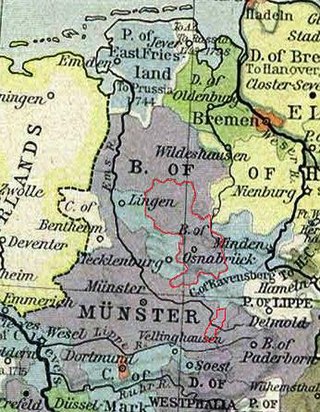
The Prince-Bishopric of Osnabrück was an ecclesiastical principality of the Holy Roman Empire from 1225 until 1803. It should not be confused with the Diocese of Osnabrück, which was larger and over which the prince-bishop exercised only the spiritual authority of an ordinary bishop. It was named after its capital, Osnabrück.
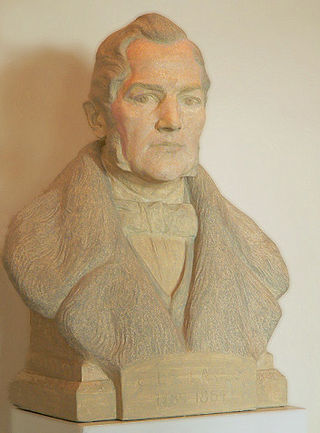
Georg Ludwig Friedrich Laves was a German architect, civil engineer and urban planner. Born in Uslar, Lower Saxony, he lived and worked primarily in the city of Hanover and also died there. He was appointed Oberhofbaudirektor, "court master builder", in 1852. As the leading architect of the Kingdom of Hanover for a career spanning 50 years, he had great influence on the urban development of this city. Alongside Karl Friedrich Schinkel in Berlin and Leo von Klenze in Munich, Laves was one of the most accomplished neoclassical style architects of Germany. As an engineer he developed a special iron truss lenticular or "fishbelly" beam bridge construction method, the so-called "Lavesbrücke". Laves found his final resting place in the Engesohde Cemetery in Hanover.

Marienburg Castle is a Gothic revival castle in Lower Saxony, Germany. It is located 15 kilometres (9.3 mi) north-west of Hildesheim, and around 30 kilometres (19 mi) south of Hannover, in the municipality of Pattensen, Hannover. It was also a summer residence of the House of Welf whose flag flies on the main tower.

Girolamo Sartonio, also known as Hieronimo Sartorio and Geronimo Sartorio, was an innovative Italian architect and engineer who worked mainly the German cities of Hanover, Hamburg, Leipzig and Erfurt. His designs were based on Palladian architecture. He was a noted expert in the installation of stage equipment and theatrical machinery and also worked as a builder or consulting architect on the construction of various opera houses, such as the Oper am Gänsemarkt in Hamburg. He is also credited with the beginnings of opera in Leipzig and the construction of the opera house in Prague.
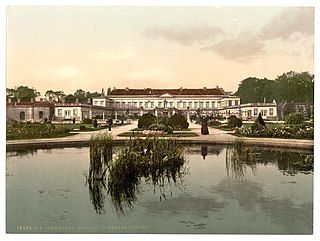
Herrenhausen Palace is a former royal summer residence of the House of Hanover in the Herrenhausen district of the German city of Hanover. It is the centerpiece of Herrenhausen Gardens.





















